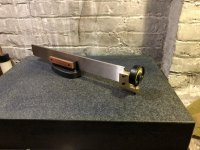jccaclimber
Stainless
- Joined
- Nov 22, 2015
- Location
- San Francisco
I’m in the process of making a few gauges which need to sit on a surface plate. Similar examples would be an indicator stand or a height master. I want them to be on 3 corner feet rather than one large flat because everything I have on large flats tends to develop a micron or two of play when the corners are pressed down. I’m wondering what the smallest practical foot size is?
I think the upper bound is a 3/8” circle because that is the diameter of the contact patch on a repeat-o-meter. In practice, while I can see occasional movement in a 2 mm indicator ball from an occasional chip, I suspect the full 3/8” isn’t needed in almost all cases. Has anyone else given this any thought, or are there any relevant standards?
I think the upper bound is a 3/8” circle because that is the diameter of the contact patch on a repeat-o-meter. In practice, while I can see occasional movement in a 2 mm indicator ball from an occasional chip, I suspect the full 3/8” isn’t needed in almost all cases. Has anyone else given this any thought, or are there any relevant standards?



